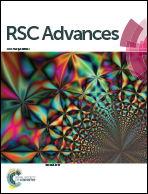Synthesis and characterization of new dual stimuli-responsive bisazobenzene derivatives†
Abstract
New organophosphonates containing bisazobenzene moieties in the main chain were synthesized by solution polycondensation reaction of 4,4′-(4,4′-(biphenyl-4,4′-diylbis(oxy))bis(4,1-phenylene))bis(diazene-2,1-diyl)diphenol and phenylphosphonic dichloride/phenyl dichlorophosphate. FTIR and NMR spectroscopy were used to confirm the chemical structure of the new compounds, while thermal properties were investigated by thermogravimetric analysis (TGA) and differential scanning calorimetry (DSC). The optical properties of these compounds were evaluated in different solvents and in the presence or absence of several external stimuli by UV-vis and fluorescence spectroscopy. The photoresponsive trans–cis photoisomerization and cis–trans relaxation process of these compounds were investigated. The absorption and fluorescence properties were sensitive to chemical stimuli (acid/base treatments). In the presence of NaOH a strong bathochromic shift of the absorption band of the bisazobenzene derivatives was observed (deprotonation). The fluorescence signal was noticeably improved upon deprotonation of the polymer solution.


 Please wait while we load your content...
Please wait while we load your content...